Lentis/Autonomous Vehicles
< LentisAn autonomous vehicle is defined as a motor vehicle that uses artificial intelligence, sensors and global positioning system coordinates to drive itself without the active intervention of a human operator. These "sensors" can include, without limitation, cameras, lasers and radar.[1] In the past several years, autonomous vehicle designers and advocates have made significant steps towards integration into the transit system and, eventually, universal autonomous transportation. This technology can revolutionize the way we approach transportation and, according to Jim McBride of Ford Research and Innovation, "there is no technology barrier from going where we are now to the autonomous car. There are affordability issues, but the big barrier to overcome is customer acceptance."[2] As autonomous vehicle advocates move closer to large-scale implementation, social factors will prove to be their largest obstacles, and they must look to the past for lessons on how to proceed.
Case Study: Lessons From the First Cars
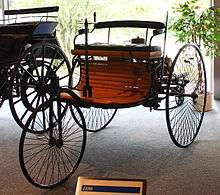
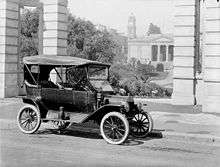
The introduction of automobiles in the late 19th and early 20th century radically changed personal transportation. These "horseless carriages" were initially modeled after the carriages that people were already accustomed to. As people gradually overcame these mental models, automobiles evolved from the horse-and-buggy style into a design similar to modern vehicles. As automobiles evolved, so did their environment. The early days of automobiles included debates on whether cars should even be allowed on roads, since roads were for carriages and pedestrians. As the ubiquity of cars increased, entire infrastructures, both physical and legislative, had to adapt to the changes in transportation; Licenses and traffic control signals became necessary for safely operating vehicles. Much like the introduction of automobiles, the acceptance of autonomous cars embodies a drastic change in the mental models of transportation. People have been driving cars for over a century, and learning to surrender all control to electronics will likely be a transition rivaling the introduction the automobile itself.
Current Technologies
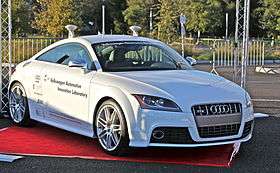
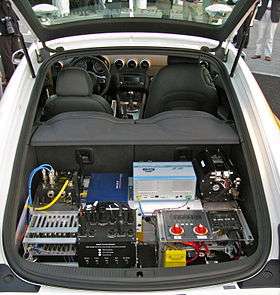
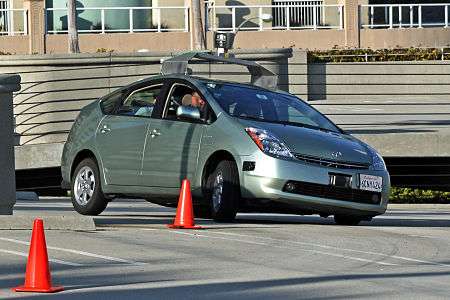
Modern vehicles have many automated technologies that assist the driver. Systems such as adaptive cruise control, lane departure warning systems, and parallel park assist apply computer control to simplify the experience of driving and improve safety. More advanced technologies, such as GM's "Supercruise" and Volkswagen's "Temporary Auto Pilot" will soon provide drivers with a true hands-free experience.[3][4]
The Stanford Racing Team was inspired to build an autonomous vehicle after observing the failure of all 15 teams in the 2004 DARPA Grand Challenge. In 2005, Stanford's autonomous car, Stanley, blazed a trail through the Mojave desert, emerging as the first car to complete the DARPA Grand Challenge.[5] Since then, Stanford has produced two more successful autonomous vehicles, Shelley and Junior.[6] Stanford has been a major player in autonomous vehicle technology. Sebastian Thrun, head of the Stanford Racing Team, is now working on the Google self-driving cars. The Google car is currently the most tested and accepted autonomous car in design. Their fleet of cars has traveled over 300,000 miles, including significant mileage on public roads. During that impressive span, only one crash has occurred: the car rear-ended another, but it was in manual mode.[7]
The University of Michigan Transportation Research Institute (UMTRI), supported by the U.S. Department of Transportation's National Highway Traffic Safety Administration, is currently in the middle of a year long experiment involving around 2800 cars, trucks, and buses equipped with connected vehicle technology.[8][9] This technology lets cars communicate with each other and alerts the driver in potentially dangerous situations in order to reduce the number of crashes. This kind of vehicle-to-vehicle communication will play a large role in the future of autonomous vehicles and this study will give valuable insight into the validity and crash prevention capabilities of the current technology.
Benefits
A transportation system of fully autonomous vehicles would revolutionize our assumptions about driving. In such a system, there would be less traffic, fewer tickets, less fuel consumed, fewer accidents, and significantly more efficient travel, among many other benefits.
Safety
According to the Insurance Institute for Highway Safety, there are 40,000 deaths from car crashes in the United States annually.[10] A study of British and American crash reports, 93% of all accidents were in some way caused by human error.[11] The rest were caused by either environmental or mechanical problems. If the autonomous vehicle can eliminate or significantly reduce car crashes caused by human error, thousands of lives could be saved every year.
Fuel Efficiency

Some cars already have a system that alerts drivers when they are accelerating inefficiently. Relinquishing human control would allow the car to adjust for optimal fuel consumption. In addition to acceleration control, vehicles communicating with each other could drive closer together, greatly decreasing wind resistance. This technique, known as "drafting" or "slipstreaming" is very effective in improving fuel economy. [12]
Optimal fuel efficiency can be attained in the more distant future. If autonomous vehicles are proven to be as safe as some experts predict, cars could be completely redesigned. Nady Boules, the director of GM’s Electrical and Controls Integration Lab predicts, “You could remove the weight dedicated to crash protection, using very light materials for the skin instead of metals.”[13] By removing unnecessary weight, vehicles will become much more fuel efficient. This could also eliminate the cost of safety technologies such as airbags.
Commuting and Traffic
Autonomous vehicles could vastly improve traffic efficiency. The Institute of Electrical and Electronics Engineers and Columbia University show that complete vehicle-to-vehicle communication would result in a 273% increase in efficiency.[14] This increased efficiency includes decreased travel times and could revolutionize the way we spend time in the car. The former driver could complete tasks that would normally have to wait until parked, and vehicles could safely become mobile offices or dining rooms. [15]
Relevant Social Groups
Car Enthusiasts and Motorcyclists
Car enthusiasts and motorcyclists will provide significant resistance to autonomous cars. Asphalt and Rubber, a prominent motorcycle advocacy group, notes that "as autonomous vehicles become increasingly the status quo on the road, user-guided vehicles like motorcycles will become greater outliers, and could face a tyranny of the majority."[16] In 2010, there were 8,217,189 motorcycles in regular use in the United States, providing a large interest group that autonomous vehicle supporters will need to take into consideration.[17]
Mothers Against Drunk Driving
One may expect that organizations such as Mothers Against Drunk Driving (MADD) would support the introduction of autonomous vehicles, since its goal is to make roads safer. However, if driverless cars successfully eliminate drunk driving, the organization would have no purpose. MADD has lobbied against driverless cars in an attempt to protect their interests. MADD shares a twisted symbiotic relationship with the drunk drivers it demonizes. MADD needs a healthy flow of ‘evil’ drunk drivers to legitimize its existence. [18]
Taxi/Truck Drivers
There are currently 239,900 taxi drivers and chauffeurs, 647,200 bus drivers, 1,604,800 heavy and tractor-trailer truck drivers, and 1,262,600 delivery truck drivers and driver/sales workers in the United States according to the Bureau of Labor Statistics.[19] These are all professions that could potentially be replaced by autonomous vehicles. As such, these are all groups that will be in strong opposition to autonomous vehicles as the technology progresses.
Disabled
Autonomous vehicle technology has clear benefits for disabled people. With self driving cars, people that were previously limited by sight or motor impairment would experience the freedom of personal mobility without the need of assistance. This benefit has already been realized by Steve Mahan, a blind man who "drove" a Google self-driving car to run some everyday errands that would otherwise be impossible.[20] The technology could help many others like Mahan gain independence in their lives.
Currently, the states where autonomous vehicles are legal still require that a licensed driver occupy the driver's seat, ready to take over driving should any error occur with the technology. Hence, for the time being, autonomous vehicles cannot liberate the physically disabled. But, as the technology proves reliable, these laws will likely change, making autonomous vehicle technology invaluable for the disabled.
Legal
Legal issues are one of the biggest potential obstacles in the way of large-scale production and use of autonomous vehicles. Because the implementation of driverless vehicles would be such a revolutionary change, it would require completely new laws governing everything from accident liability to licensing.
Nevada (June 6, 2011), California (February 23, 2012), and Florida (July 1, 2012) have all passed legislation allowing the testing and general use of autonomous vehicles on public roads.[21][22][23] New Jersey, Hawaii, Oklahoma, Arizona, and the District of Columbia, are also considering bills. [24]
A primary goal of developing autonomous vehicles is to improve safety. "Computers don't go to bars, don't text and react more quickly than a race car driver. They enjoy a 360-degree view of their surroundings and never get tired." Because the accident rate would most likely drop drastically, the number of insurance claims will drop too. Insurance premiums are predicted to drop by up to 80% by 2022 with the introduction of more intelligent safety systems.[25]
One of the biggest questions regarding driverless vehicles is that of liability. Who gets ticketed if the car fails to adjust its speed through a temporary construction zone? Who is responsible when an autonomous vehicle is involved in an accident? By removing the driver, the blame would most likely shift to the manufacturers or software developers. Torts attorney Thomas J. Simeone predicts, "The driver of the car will become a witness and will have an incentive to testify against the manufacturer -- to shift legal responsibility away from himself." Auto manufacturers will most likely hesitate to accept this liability and blame may shift back to the owner of the vehicle for poor maintenance or failure to download updated software patches.[25][26]The Alliance of Automobile Manufacturers (AAM), a group accounting for 77% of all U.S. car and truck sales, warns, "If the state's intention is to promote autonomous vehicles, all the concerns - like liability - need to be properly addressed in advance or we can expect a bumpy road ahead.[27]" AAM supports autonomous vehicles, though they have been concerned with potential legal problems. In the process of California's legislation for autonomous vehicles, AAM lobbied heavily against it. Despite their efforts, Google managed to push the bill through; however, these legal issues must be addressed for acceptance of autonomous cars.
Conclusion
Despite the inherent benefits, autonomous vehicle technology must overcome many social barriers. Much like the issues faced by the first automobiles, the influence of mental models can impede the advancement of technology. However, new legislation is creating opportunities for these cars to prove their viability. The ongoing research and testing done by organizations such as Google and Stanford will only prove to advance the acceptance of autonomous cars. As more states legalize driverless cars, the social obstructions will give way, allowing for the largest revolution in personal transportation since the introduction of automobiles.
General Motors predicts, "the industry will experience a dramatic leap in active safety systems"[28] and plans to release a fully autonomous vehicle by 2020.[29] The Institute of Electrical and Electronics Engineers "selected autonomous vehicles as the most promising form of intelligent transportation, anticipating that they will account for up to 75 percent of cars on the road by the year 2040."[30][31]
References
- ↑ Nevada Bill Legalizing Autonomous Vehicles
- ↑ Ford is Ready For the Autonomous Car. Are Drivers?
- ↑ Volkswagen's 'Temporary Auto Pilot' will drive your car up to 80 mph
- ↑ General Motors' Supercruise Technology Aims to Bring Accident-Free Car
- ↑ The Stanford Racing Team
- ↑ Stanford's Robotic Audi to Brave Pike's Peak Without a Driver
- ↑ Google's Self-Driving Car Passes 300,000 Miles, Employees to Start Commuting With It
- ↑ Connected Vehicle Technology Fact Sheet
- ↑ Safety Pilot Model Deployment Technical Fact Sheet
- ↑ Car Crashes Kill 40,000 In U.S. Every Year
- ↑ Interactive Highway Safety Design Model: Accident Predictive Model
- ↑ ‘Hypermilers’ wring out every last bit of mpg
- ↑ How Vehicle Automation Will Cut Fuel Consumption
- ↑ Robot Cars Would Increase Highway Efficiency By 273%: Study
- ↑ Lentis - How Cars Became Dining Rooms
- ↑ As California Legalizes Self-Driving Cars, Are Motorcycling's Days Numbered?
- ↑ National Transportation Statistics 2012
- ↑ MADD vs Drunk Driving
- ↑ United States Department of Labor: Bureau of Labor Statistics
- ↑ Self-Driving Test Car: Steve Mahan
- ↑ CS/HB 1207 Vehicles with Autonomous Technology - Florida
- ↑ Senate Bill 1298 - California
- ↑ AB 511 Committee on Transportation - Nevada
- ↑ Automated Driving: Legislative and Regulatory Action
- 1 2 Will driverless cars cut your rates 80 percent?
- ↑ Driverless cars: Around the corner?
- ↑ Drive Towards Autonomous Cars Shouldn't Be So Automatic, Critics Warn
- ↑ GM: Self-Driving Vehicles Could be Ready by End of Decade
- ↑ GM: Expect self-driving vehicles by 2020
- ↑ Group Of Smart People Claim 75% Of Vehicles Will Be Autonomous By 2040
- ↑ IEEE Says That 75% Of Vehicles Will Be Autonomous By 2040